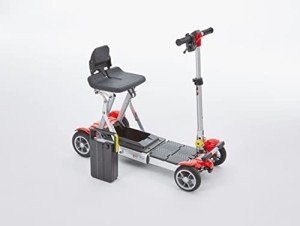Understanding Mobility Devices: Enhancing Independence and Quality of Life
In today's busy world, the desire for mobility is universal. Nevertheless, travel mobility scooters or age-related difficulties can prevent movement, resulting in a continuous look for help. Mobility devices act as important tools to enhance self-reliance, enhance quality of life, and make it possible for individuals to engage fully in their neighborhoods. This short article supplies an extensive introduction of mobility devices, including their types, functions, choice requirements, and more.
Kinds Of Mobility Devices
Mobility devices range from easy aids to intricate devices, customized to satisfy various requirements. Below is a table summing up typical kinds of mobility devices:
| Type of Device | Description | Ideal For |
|---|---|---|
| Walkers | Four-legged support devices that offer superior stability while strolling. | People requiring extra assistance. |
| Walking canes | Single or three-legged sticks that improve balance and assistance walking. | Those with slight mobility troubles. |
| Wheelchairs | Seats mounted on wheels, offered in handbook and electric versions. | Individuals with restricted or no mobility. |
| Scooters | Electric lorries designed for outside usage and ease of navigation. | Those who can't walk fars away. |
| Crutches | Devices that help people transfer weight away from a hurt leg. | Individuals recuperating from leg injuries. |
| Rollators | Walkers with wheels, seats, and brakes for boosted mobility. | Users requiring rest alternatives while strolling. |
| Raise Chairs | Reclining chairs that help users in standing up and taking a seat. | Seniors or those with mobility restraints. |
| Mobility Scooters | Small electric lorries for restricted mobility, often used outdoors. | Individuals requiring help over long ranges. |
Key Features of Mobility Devices
When selecting a mobility gadget, numerous key functions ought to be considered to ensure ideal performance and ease of use:
- Weight Capacity: Understanding the gadget's weight constraint is essential for safety and efficiency.
- Adjustability: Devices should be adjustable in height and width to fit the user easily.
- Portability: Lightweight and foldable options are essential for users who travel or require transportation.
- Stability and Safety: Look for functions like anti-tip wheels and tough structures to boost security.
- Alleviate of Use: Simple systems and easy to use styles can make a considerable distinction in everyday use.
- Convenience: Ergonomic styles and cushioned seats can boost the user experience.
Choosing the Right Mobility Device
Picking the ideal mobility device can be a daunting task. Here are some actions to guide the decision-making process:
- Assess Needs: Evaluate the individual's mobility challenges and everyday activities.
- Seek advice from a Professional: Engage healthcare experts who can provide suggestions based on the person's physical condition.
- Trial Options: If possible, trial different devices to figure out comfort and functionality.
- Evaluation Budget: Consider the cost of the gadget, consisting of any additional functions or adjustments required.
- Research Options: Determine the best brand names and designs by reading reviews and comparisons.
Table: Comparative Analysis of Popular Mobility Devices
| Device | Advantages | Drawbacks |
|---|---|---|
| Walkers | Excellent stability, promotes strolling. | Bulky, may restrict motion in small areas. |
| Walking sticks | Lightweight, boosts balance. | Might not offer enough assistance for extreme mobility issues. |
| Wheelchairs | Perfect for those with substantial mobility restrictions. | Can be troublesome, especially in indoor environments. |
| Scooters | Great for outside use, easy to maneuver. | Restricted indoor functionality, heavier. |
| Rollators | Provides rest option, easy to move. | May require more area than standard walkers. |
| Lift Chairs | Comfy, assists shift from sitting to standing. | More pricey, larger footprint. |
Regularly Asked Questions (FAQs)
1. What is a mobility gadget?
A mobility gadget is any tool created to help individuals in moving and navigating their environment. This includes walkers, wheelchairs, scooters, and crutches.
2. How do I know which mobility gadget is best for me?
Consider your specific mobility obstacles, physical capabilities, and way of life needs. Consulting with healthcare professionals can also offer tailored suggestions.
3. Are mobility devices covered by insurance?
Numerous insurance plans, consisting of Medicare, might cover specific mobility devices. It's crucial to talk to your insurance supplier for specific coverage details.
4. Can I lease a mobility gadget rather of purchasing one?
Yes, lots of medical supply shops and drug stores offer leasings for mobility devices. This choice is beneficial for people with momentary mobility concerns.
5. How can I keep my mobility gadget?
Regular upkeep is crucial. It includes cleaning up the device, looking for wear and tear, and guaranteeing all parts are functioning properly.
The Impact of Mobility Devices on Quality of Life
Mobility devices significantly improve the quality of life for individuals with minimal mobility. They foster independence, motivate social interaction, and improve access to important services and leisure activities.
- Increased Independence: Users can navigate their neighborhoods, attend occasions, and engage in hobbies without relying on others.
- Social Engagement: Mobility devices facilitate participation in celebrations, therefore combating feelings of isolation.
- Enhanced Safety: Devices offer stability and minimize the risk of falls, promoting user confidence.
Mobility devices are more than simply tools for movement; they are entrances to self-reliance and quality living. By comprehending the different types of mobility aids available, their key functions, and factors to consider for picking the ideal gadget, individuals can make educated decisions about their mobility requires. Eventually, the right mobility gadget can result in a more active, satisfying life. Whether it's a walker, wheelchair, or scooter, the ideal option contributes considerably to improving the mobility and self-reliance of users.

